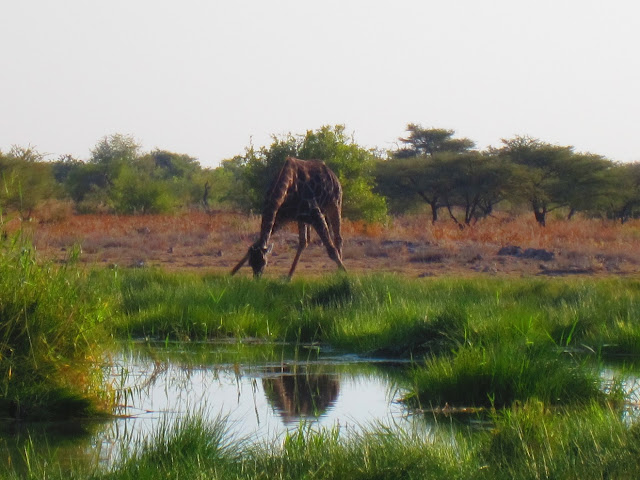And now it
was time to enter Namibia’s number one tourist highlight: the Etosha
Nationalpark. As usual in Africa these nationalparks cover a huge area but what
we didn’t know is that more than half of the national park is a white pan, a
dried out lake in which nothing grows or lives. The rest is either bushland or
steppe. The campsites and roads are around this pan. We decided to make the
most of this and wanted to stay at each of the 3 campsites, giving us 3 days in
the nationalpark. And it didn’t take long to spot the “usual suspects” like
springboks and oryx but we also didn’t have any problems to see zebras, kudus
and giraffes. And pretty quickly we figured out that kudus and impalas are more
likely to be met in the bush where they were hiding, also red hartebeests (a
little more shy than the others) and elephants, but elephants had problems with
hiding anyway. On the other hand springboks, zebras, wildebeests were more
comfortable in the wide open of the steppes. Also lions we saw more often in
the open plains and giraffes… yeah, giraffes were easily visible everywhere. Jackals
liked every place where there was food around, be it the campsite or a
half-eaten wildebeest. We were lucky enough to watch hyenas trying to defend
their feed from the jackals which they had just stolen the lions. Rhinos liked
the bushes and the waterholes and honey badgers and little steenboks (look it
up, it’s cute!) crossed our way on escape.
Speaking of
waterholes… I was quite disappointed to learn that each campsite (which is in
fact a resort to which also chalets, shops and restaurants belong) had its own
floodlit waterhole which was easily accessible to everybody and I even heard
that some guests just hang out at the waterhole the whole day and still could
brag about having seen all major animals of the park! What difference to the
zoo is that?
The most
common species to be found at the waterholes is the Canon Eos, mostly connected
to Germans. It’s amazing how much equipment some people bring keeping them busy
the whole time finding the right focus, right settings, right light, right
shutter speed… and in fact they miss out on the real experience. Nobody is
looking at the scene, everybody is busy with the cameras. And I guess only at
home they will realize what they have recorded. I must admit that I do realize
the limitations of my Canon Ixus. It has always served me well but it’s
definitely not made for crystal clear pictures of animals from the distance. So
I personally concentrate on the scene itself, soak up the atmosphere, get
caught in the moment and not worry too much about having any evidence about the
just experienced. I just hope that the pictures of munching hyenas,
roughhousing zebras, roaring lion and running giraffes stay in my head anyway.
And by the way, none of these scenes happened at the floodlit waterholes.
Getting up early and leaving the campsite at sunrise is a guarantee for more
unique pictures than just documenting what passed by the waterhole.
After 3
days in the national park we kind of had enough. Problem is, with all the lions
and dangerous animals around you cannot do anything else but driving around. No
hiking, no activities whatsoever. So we did around 3hours drive in the morning,
relaxed on the poolside during the day and took off for another 1-2hours drive
before sunset. But at the 3rd day we didn’t find anything what we
haven’t seen before, so it was about time to move on.




No comments:
Post a Comment